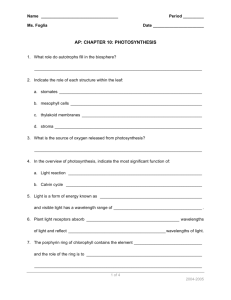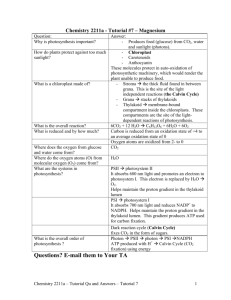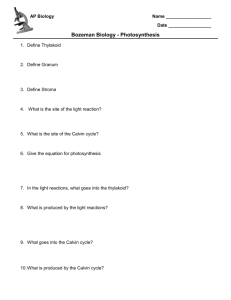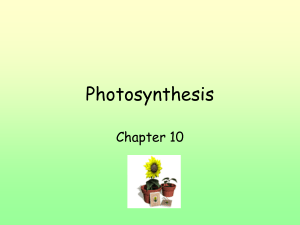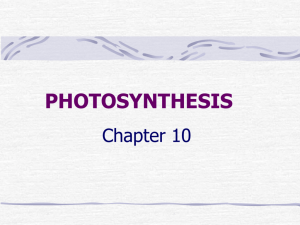Photosynthesis
advertisement
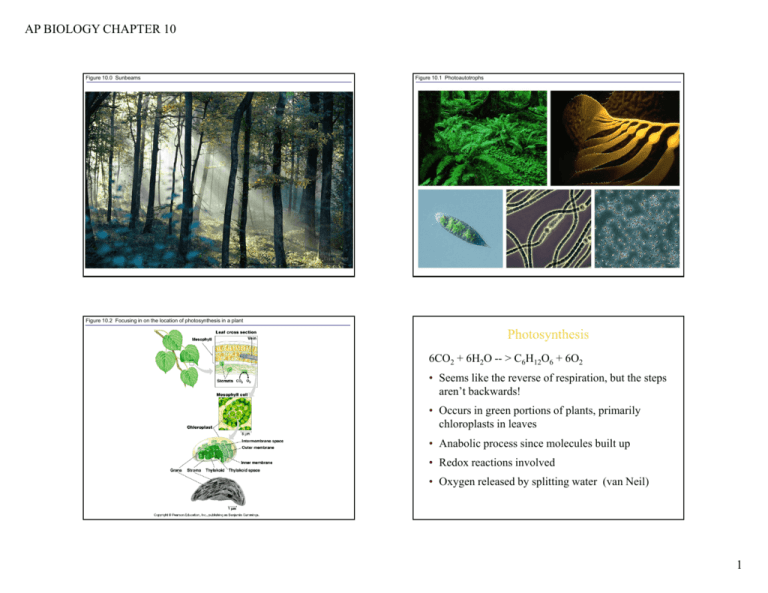
AP BIOLOGY CHAPTER 10 Figure 10.0 Sunbeams Figure 10.1 Photoautotrophs Figure 10.2 Focusing in on the location of photosynthesis in a plant Photosynthesis 6CO2 + 6H2O -- > C6H12O6 + 6O2 • Seems like the reverse of respiration, but the steps aren’t backwards! • Occurs in green portions of plants, primarily chloroplasts in leaves • Anabolic process since molecules built up • Redox reactions involved • Oxygen released by splitting water (van Neil) 1 AP BIOLOGY CHAPTER 10 Figure 10.3 Tracking atoms through photosynthesis Figure 10.4 An overview of photosynthesis: cooperation of the light reactions and the Calvin cycle (Layer 3) Figure 10.5 The electromagnetic spectrum Reactions Overview • Light reactions: cyclic and non-cyclic photophosphorylation • Dark reactions: Calvin cycle • Light reactions use pigments (chlorophyll a, b, carotenoids) to capture light. Pigments located along thylakoid membranes, organized into reaction centers • P680 (photosystem II) and P700 (photosystem I) absorb light best at 680 and 700 nm. The light is in the visible part of electromagnetic spectrum. 2 AP BIOLOGY CHAPTER 10 Figure 10.6 Why leaves are green: interaction of light with chloroplasts Figure 10.7 Determining an absorption spectrum Figure 10.8 Evidence that chloroplast pigments participate in photosynthesis: absorption and action spectra for photosynthesis in an alga Figure 10.9 Location and structure of chlorophyll molecules in plants 3 AP BIOLOGY CHAPTER 10 Figure 10.09x Chlorophyll Figure 10.10 Excitation of isolated chlorophyll by light Figure 10.11 How a photosystem harvests light Reactions Overview • Photosystems create ATP through photophosphorylation. • Noncyclic: PS2 generates ATP, PS1 generates NADPH, water split by sunlight (photolysis) • Cyclic: PS1 generates ATP, no NADPH, no split of water • Both reactions occur in thylakoids 4 AP BIOLOGY CHAPTER 10 Figure 10.12 How noncyclic electron flow during the light reactions generates ATP and NADPH (Layer 5) Figure 10.13 A mechanical analogy for the light reactions Figure 10.14 Cyclic electron flow Figure 10.16 The light reactions and chemiosmosis: the organization of the thylakoid membrane 5 AP BIOLOGY CHAPTER 10 Figure 10.15 Comparison of chemiosmosis in mitochondria and chloroplasts Calvin Cycle • Products of light rxn are used to make sugar • CO2 source of carbon • CO2 turned into carbs through carbon fixation • Also called the C3 pathway Figure 10.17 The Calvin cycle (Layer 3) Special Considerations • Photorespiration is a relic of earlier times when CO2 was more prevalend, O2 less. • O2 enters Calvin cycle instead of CO2 • No ATP produced • Fostered in hot, dry conditions 6 AP BIOLOGY CHAPTER 10 Figure 10.18 C4 leaf anatomy and the C4 pathway C4 and CAM • C4 plants use an alternate form of Calvin cycle • PEP carboxylase accepts CO2, not rubisco • Bundle sheath and mesophyll cells separate initial carbon fixation from the cycle itself • CAM plants function well in hot, arid conditions. • Stomata open at night, close during day. • Light reactions during day, Calvin cycle at night. Figure 10.19 C4 and CAM photosynthesis compared Figure 10.20 A review of photosynthesis 7







